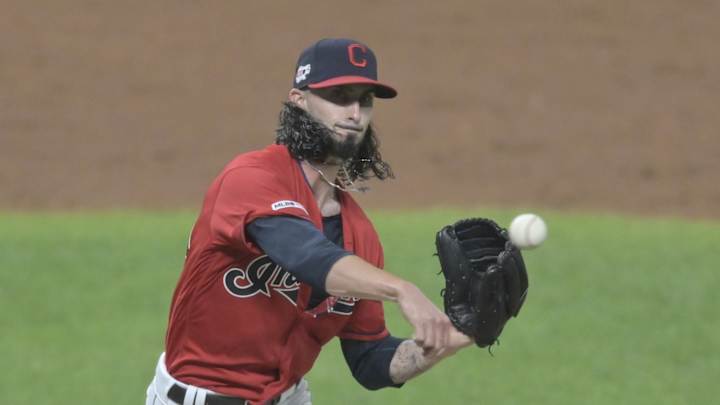Indians Mystery: Hunter Wood and the Curious Case of the Missing Curveball

Back in spring training -- the original, not the reboot -- I discussed the likelihood of reliever Hunter Wood making the Cleveland Indians’ opening day roster.
On the surface, he seemed like a lock, especially considering the team just traded for him last summer and he’s fresh out of options. Still, there were concerning trends from Wood’s Cleveland debut last year, and his spring performance did little to alleviate them.
In response to this piece, Michael Augustine of FanGraphs suggested Wood should work on his curveball. After all, there’s barely any horizontal movement on his four-seamer, so pairing it with a decent curve could improve his overall performance.
When exploring this suggestion further, you learn two things.
One -- Wood’s curve is actually deceivingly effective despite it boasting an underwhelming spin rate.
Two -- he barely ever throws it.
It’s honestly quite perplexing. Wood’s curve may not be incredibly imposing, yet hitters still struggle to make effective contact against it. Why he under-utilizes this pitch despite both this and issues he’s experiencing with keeping the ball in the park remains a bit of a mystery.
For a quick recap, while Wood ended last season with a 2.98 ERA, several of his stats serve as red flags. His 11.1% HR/FB rate was a bit concerning considering FanGraphs views 9.5% as average, and his FIP jumped from 3.70 to 4.36 year-over-year.
Likewise, a couple retroactive metrics highlight how misleading his ERA and FIP might’ve been.
His 2019 SIERA (Skill Interactive ERA) -- which estimates what someone's ERA should’ve been by comparing him to pitchers with similar strikeout rates, walk rates and ground ball percentage -- landed at 4.49.
Meanwhile, his xFIP -- which uses the same calculations as FIP, but estimates how many home runs a pitcher should’ve allowed given the number of fly balls surrendered -- was 5.12, well over what FanGraphs views as average (3.80).
Long story short, Wood’s surface-level numbers seem fine, but you can poke holes in them. That he logged a 19.64 ERA and a HR/9 of 7.4 during spring training did little to convince you otherwise, nor does the fact all projections outlets see his ERA jumping into the 4’s this season.
With the backstory out of the way, let’s get back to that curveball.
As mentioned, Wood’s curve is noticeably underutilized, especially last season. 17.8% of his 696 pitches thrown in 2018 were curveballs. In 2019, that usage percentage dropped to 5.1% of his 752 pitches.
One reason for this may have been a drop-off in, well, drop.
Wood’s curve dropped an average of 67.9 inches in 2018, 7.0 more inches than similar curveballs at his velocity. Only eleven pitchers had more added drop in their curve than Wood that season.
Last year, his curve only had 3.9 more inches of added drop vs. average. It’s not bad, but a notable change.
Despite this, it’s still a bit difficult to explain why Wood all but ditched this pitch last season. Honestly, the more you dig into that decision, the stranger it seems.
For one, outside of his four-seamer, Wood’s curveball is his only other evenly-distributed pitch. All but 14 of his 211 sliders were thrown against righties last year. Of his 85 changeups thrown in 2019, 83 were served up against southpaws.
Meanwhile, 55% of his curves were thrown at lefties vs. 45% offered to right-handers. Basically, Wood is confident enough to throw a curveball no matter which side of the plate a hitter stands, but not confident enough to throw it frequently.
Making matters more confusing is what happens when you look at how hitters have fared against his pitches over the past two seasons.
Slider
2018 -- 157 pitches, .283 avg, 16.7% strikeout rate, .297 wOBA
2019 -- 211 pitches, .277 avg, 29.9% strikeout rate, .326 wOBA
Four-Seamer
2018 -- 367 pitches, .274 avg, 17.2% strikeout rate, .375 wOBA
2019 -- 418 pitches, .274 avg, 10.9% strikeout rate, .332 wOBA
Changeup
2018 -- 48 pitches, .333 avg, 35.7% strikeout rate, .350 wOBA
2019 -- 85 pitches, .238 avg, 17.4% strikeout rate, .246 wOBA
The fastball is clearly his favored pitch, despite the high wOBA opposing hitters have against it. Likewise, righties generated stronger results against his slider last year, while lefties had trouble making contact count against his changeup.
Now let’s compare these numbers to those against Wood’s curve.
2018 -- 124 pitches, .179 avg, 48.3% strikeout rate, .164 wOBA
2019 -- 38 pitches, .000 avg, 41.7% strikeout rate, .115 wOBA
The numbers speak for themselves.
Wood has thrown 162 curves over the past two seasons, giving up only five hits, all of which came in 2018. Of the 38 curveballs he threw last year, only five were put into play. Only one batted ball left the infield, and it came on an error.
So why is Wood so hesitant to use this pitch?
As mentioned, the spin rate isn’t great. Baseball Savant ranks it in the 26th percentile. Yet, opposing hitters’ numbers against it are still, to date, poor.
Perhaps Wood just prefers utilizing his curve as a cameo pitch, using it so infrequently solely to catch hitters off guard. That said, 56.8% of the curves he’s thrown over the last two years landed in the heart or shadow zone of the plate, so it isn’t as if it’s a junk pitch he’s trying to get hitters to chase.
In conclusion, the best answer I can give for this mystery is -- ¯\_(ツ)_/¯.
I’m not here to tell a pitcher how to do his job, nor am I trying to portray Wood’s curve as one of the league’s deadliest pitches.
Still, considering the severely paltry numbers opposing hitters have against it, you can see why increasing his curve usage might serve Wood well in the long run.
